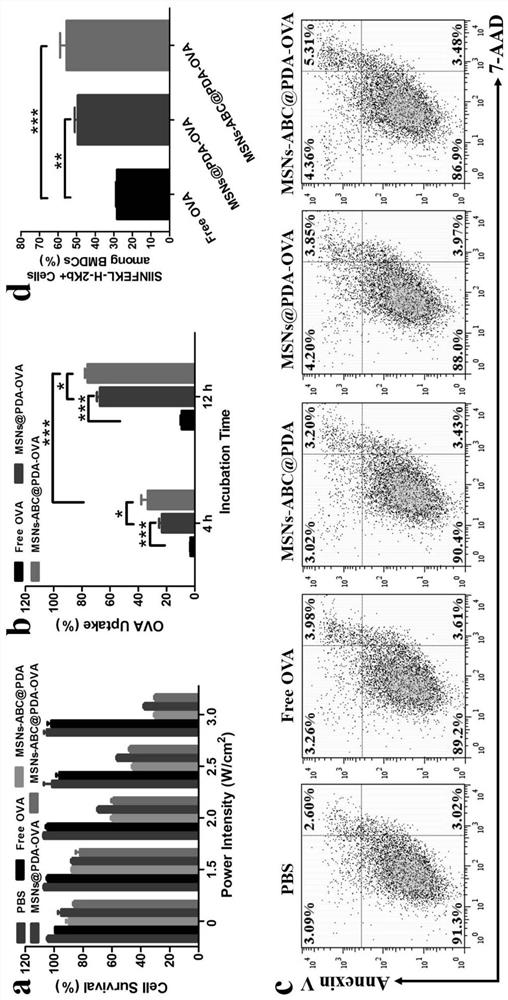PH-responsive mesoporous silicon nanoparticle treatment vaccine based on co-entrapped antigen and photosensitizer as well as preparation method and application thereof
A technology of mesoporous silicon nanoparticles and therapeutic vaccines, applied in the field of therapeutic vaccines, can solve the problems of poor curative effect and multiple immunizations, and achieve the effects of low cost, elimination of in situ tumors, and simple surface modification
- Summary
- Abstract
- Description
- Claims
- Application Information
AI Technical Summary
Problems solved by technology
Method used
Image
Examples
Embodiment 1
[0072] This embodiment provides a pH-responsive therapeutic vaccine based on mesoporous silicon nanoparticles that co-encapsulate antigens and photosensitizers. The preparation method includes steps:
[0073] S1: Weigh 25 mg of mesoporous silicon nanoparticles (MSNs) into 5 mL of 2M ammonium bicarbonate solution, and in an ice bath, use a 3 mm probe and an ultrasonic cell disruptor with a power of 30% to sonicate for 5 minutes (sonication for 5 seconds and stop for 3 seconds) , to obtain a nanoparticle solution, continue to incubate at 4° C. with shaking overnight (>10 h), then centrifuge at 15,000 rpm for 10 min, wash twice with deionized water, and collect the precipitate.
[0074] S2: Resuspend the above precipitate with 1mL Tris-HCl solution (10mM, pH 8.5), then add 4mL Tris-HCl solution (10mM, pH 8.5) containing 25mg dopamine hydrochloride under shaking conditions, and continue shaking for 6h under dark conditions Above, centrifuge at 15000rpm for 10min, wash twice with d...
experiment example 1
[0091] 1. Particle size and potential measurement
[0092] figure 1 a and b are the particle size and Zeta potential diagrams of MSNs, MSNs@PDA, MSNs-ABC@PDA, MSNs@PDA-OVA and MSNs-ABC@PDA-OVA, respectively; figure 1 c in PBS, free OVA, MSNs-ABC@PDA, MSNs@PDA-OVA and MSNs-ABC@PDA-OVA in 808nm laser (2.5W / cm 2 , 5min) under the temperature rise curve; figure 1 d, e and f are the cumulative antigen release curves of MSNs@PDA-OVA and MSNs-ABC@PDA-OVA under laser irradiation or without laser irradiation in PBS release solution with pH 7.4, 6.5 and 5.0, respectively .
[0093] For details on particle size, see figure 1 In a, the result shows that the average particle size of the prepared vaccine based on mesoporous silicon nanoparticles is below 300nm; the results of the potential measurement are shown in figure 1 In b, the results show that the prepared mesoporous silicon nanoparticle-based vaccine has a stable negative potential value.
[0094] 2. Encapsulation efficiency o...
experiment example 2
[0106] 1. Photothermal toxicity of the pH-responsive therapeutic vaccine (MSNs-ABC@PDA-OVA) based on mesoporous silicon nanoparticles co-encapsulating antigens and photosensitizers prepared in Example 1 of the present invention on B16-OVA tumor cells detection
[0107] B16-OVA cells were seeded into 96-well plates (10 per well 3 cells) were cultured overnight, then the culture medium was discarded, and 100 μL of PBS, free OVA, MSNs-ABC@PDA, MSNs-ABC@PDA-OVA and MSNs-ABC@PDA-OVA (the equivalent OVA concentration was 25 μg / mL) were added respectively. Culture medium continued to grow. After incubation for 2 h, the cells were irradiated with 808 nm laser light with different power intensities for 5 min. After further incubation for 22 h, the cells were washed with PBS and added to 100 μL RPMI1640 medium containing 20 μL MTS for 30 min. Measure the absorbance at 490nm with a microplate reader, and calculate the cell viability according to the following formula:
[0108] Cell su...
PUM
| Property | Measurement | Unit |
|---|---|---|
| particle size | aaaaa | aaaaa |
Abstract
Description
Claims
Application Information
 Login to View More
Login to View More - R&D
- Intellectual Property
- Life Sciences
- Materials
- Tech Scout
- Unparalleled Data Quality
- Higher Quality Content
- 60% Fewer Hallucinations
Browse by: Latest US Patents, China's latest patents, Technical Efficacy Thesaurus, Application Domain, Technology Topic, Popular Technical Reports.
© 2025 PatSnap. All rights reserved.Legal|Privacy policy|Modern Slavery Act Transparency Statement|Sitemap|About US| Contact US: help@patsnap.com



